Atlantis-Kurzanleitung
This is an abbreviated rule for Atlantis that only describes the online interface. Knowledge of the rules is required.
Game board
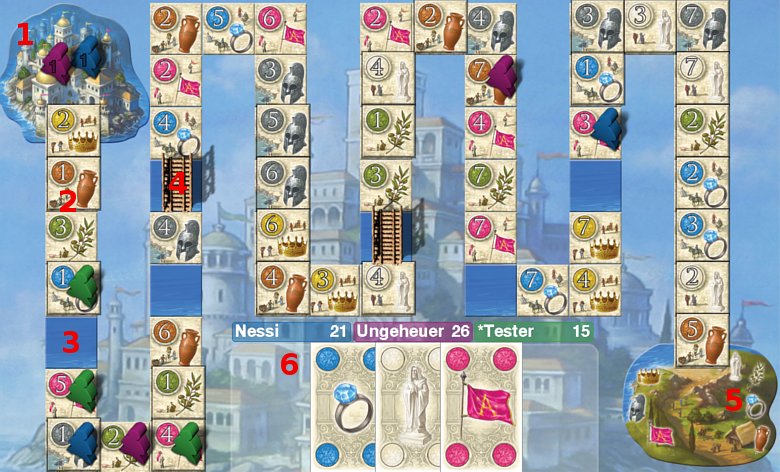
- Atlantis starting area
- Course tiles with values from 1 to 7
- Water hole
- Bridge
- Continent arrival zone
- Player display
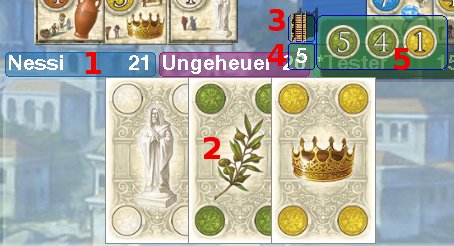
- Player name and current points
- His cards in hand
- Deck display (whether player has already built it or not)
- Number of cards in hand
- Tiles collected
Move a pawn
To move a pawn, the active player must first choose a pawn he wishes to move and click on it. At this point, the various squares that can be reached using his Movement cards are displayed.
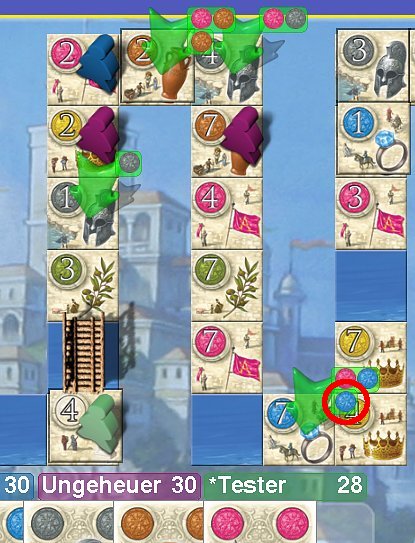
Example: The green player has chosen his pawn at the bottom left. He has one blue, one gray, one brown and one pink card. The green arrows show him which squares he can end his turn on.To the right next to the green arrow is shown each time which card is needed for this move. To move to gray one, for example, he only needs a gray card. To reach the gray four, he can first play the pink card. As the pink two is occupied, he must continue playing and can reach the next gray square by playing the gray card, in this case the gray four. To reach the brown two or the blue seven, he also has two options for each. He can reach it directly with a brown or blue card, or if he plays the pink card first, he can also reach his goal with two cards. To select the desired destination, simply click on the corresponding colored dot next to the green arrow. As the Green player wishes to go to the blue seven with a single blue card, he must click on the point circled in red.
To build a bridge, click on the desired water area.

To finish building, click on the confirm button.
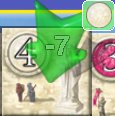
The cost you have to pay for a route with water zones is displayed when you hover the mouse over the corresponding target green arrow.

When you've chosen your turn and clicked on a colored dot, this window opens as soon as you've had to cross an area of water. It shows how much you have to pay to cross the water. You can then pay with collected Course tiles and/or cards in hand.
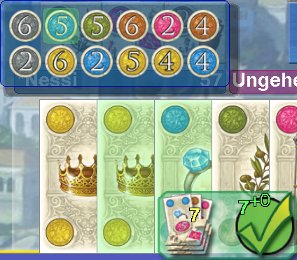
To do this, hover the mouse over its name and select the corresponding points there and/or click on cards in hand. When you have clicked on the amount you want, you validate with the green tick.
Beware: you can also (voluntarily or not) pay more! If, for example, you only have to pay One, but you only have course tiles with more points and more cards in your hand, you must pay more! In other words, you have to give a tile with a higher value and lose the excess points. If you weren't careful when choosing or are starting over, it's strongly advised to pay attention to the number indicated in the green tick, to avoid unintentionally overpaying.
As the player has not yet collected a seven tile, he must make a mix: he chooses the blue five tile and adds two of his cards to it.

Special case: when a player cannot make a valid turn with his cards in hand, he must pass this turn. He receives two Movement cards as compensation.
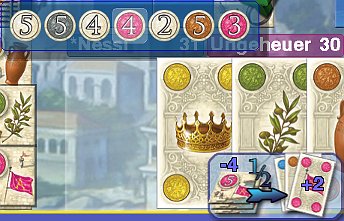
At the beginning of his turn a player can buy Movement cards by giving back a Points tile. To do this, at the start of his turn he must mouse over his name to call up the Points tiles. He can then choose a tile and receive half the value (rounded down) in cards.

